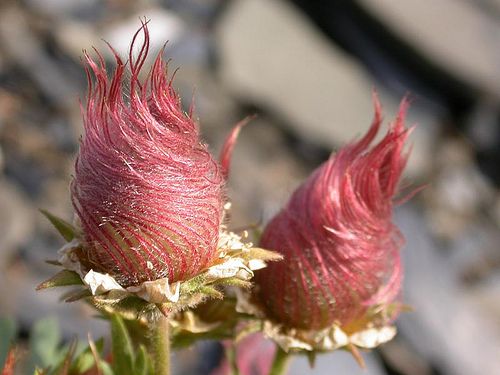Creeping Avens
Creeping avens, otherwise known as Geum reptans, can provide a cheery supplement to any home garden.
The yellow blooms grow as a natural ground cover and thrive well in smaller areas with regular maintenance.
What are Geum Reptans?
A member of the rose family, Geum reptans (syn. Sieversia reptans) is a low-growing perennial plant that produces buttery, yellow blooms in the late spring or summer climate.
Eventually, the flowers wilt and develop attractive fuzzy, pink seedheads.
Also known as the creeping avens plant for its long, red, strawberry-like runners, this hardy plant is native to the mountain regions of Central Asia and Europe.
How to Grow Geum Creeping Avens
The creeping avens plant is suitable for growing USDA hardiness zones 4 through 8.
Some sources say the plant is hardy only to zone 6, while others say it is tough enough for climates as low as zone 2.
Either way, the growth of this plant appears to be relatively short-lived.
In the wild, creeping avens prefer rocky, gravelly conditions. In the home garden, it does well in gritty, well-drained soil.
Look for a location in full sunlight, although afternoon shade is beneficial in warmer climates.
Plant seeds directly in the garden after all danger of frost has passed and daytime temperatures reach 68 F. (20 C.)
Alternatively, start seeds indoors six to nine weeks ahead of time. Seeds usually germinate in 21 to 28 days, but they may take much longer.
Creeping Avens Care
When caring for Geum reptans, water now and then during hot, dry weather.
Creeping avens plants are relatively drought-tolerant and don’t require a lot of moisture.
Deadhead wilted blooms regularly to promote continued blooming.
Cut plants back after flowering to refresh and rejuvenate the plant. Divide every two or
three years.
Other Reptans
The perennial Geum reptans L. (Rosaceae) is an outcrossing clonal rosette plant distributed from the Central Alps eastwards to the Carpathian Mountains and Macedonia.
The species preferentially on moist moraines and alluvial soils of glacier forelands, on screes, and mountain ridges, preferring lime deficient rocks between 1,950 m and 3,800.
Geum reptans is one of the original pioneers invading protocols after glacier retreat. Individual plants are long-lived and consist of clumps of one to many rosettes attached to a
taproot.
Individual plants reproduce in early summer by seeds and by vegetatively produced daughter rosettes.
The clonal daughter rosettes (ramets) are formed at the above-ground stolons and produce adventitious roots. Hermaphroditic, predominantly fly-pollinated flowers include seeds.
At the end of summer, stolons, daughter rosettes that could not be established, and adult plants’ leaves die back.
The diameter of a clonal patch usually does not exceed four meters.
The age at first reproduction largely depends on environmental conditions and varies among populations.
Mountain Avens
It is a beautiful plant that looks great compared to the rough, rocky places it grows. Although this plant is often confused with white-flowered Saxifrage, it has five petals, whereas mountain Avens has eight.
It can sometimes have twice that number, with as many as 17 species recorded. The seed heads look almost as beautiful as the flowers and resemble the flight feathers of a bedraggled duck.
Most Asked Questions On Creeping Avens
1. Are Creeping Avens invasive?
For instance, Lamium can be used as a groundcover, but it can also spread aggressively. Creeping Avens is a less aggressive variety, adds brilliant chartreuse color to shady borders and clusters rose-purple flowers.
2. Are Creeping Avens real?
Although the name of this plant might sound as if it came from a science fiction movie or some ancient tale of monstrous creeping plants, the truth is different.
It is a natural plant, as you have already discovered by reading this article.
3. Do Geums like shade?
Answer to this question can also be found in this article since Geums grow in natural habitats on mountains, slopes, and glaciers; this can mean only one thing. Geums prefer a sunny environment and tolerate light shade only for a brief period.
4. Do Geums grow in Australia?
No, and even if they do, authorities consider them to be “alien plant species,” They do all they can to eradicate it from Australian soil.
Consider Health Benefits
The benefits of growing these flowers don’t stop in your garden.
They seem to have significant health gain as well!
In Austria, people use it in traditional medicine.
These flowers are used as a tea and allegedly treat gout, infections, fever, and herbalist and treat diarrhea, heart disease, halitosis, and mouth ulcers.
However, before you decide to try it, consult your doctor first.
Final Word
Creeping Avens (Geum reptans), also known as herb bennet, yellow-flowered mountain avens, and blessed herb, is a fascinating and colorful perennial plant belonging to the Rosaceae family.
This hardy plant, native to the mountainous regions of Central Asia and Europe, thrives in well-draining, moist soil with sufficient sun exposure. As a drought-resistant and cold-tolerant plant, it can survive frost, high temperatures, and some pests and diseases.
Its eye-catching yellow flowers, which eventually turn into cotton candy-like pink seedheads in late spring or early summer, make it a stunning addition to gardens. For optimal growth, ensure that your planting site offers full sun, and provides afternoon shade in hotter climates.
Proper care, including regular watering, adding organic matter such as compost, and fertilizing, will help the plant establish and produce more blooms throughout the growing season.
Be cautious of potential root rot and divide creeping avens mature plants in early spring to control its growth and prevent it from becoming invasive.
With these helpful tips and continued attention, your creeping avens plants will brighten your outdoor spaces and delight gardeners for years to come.























